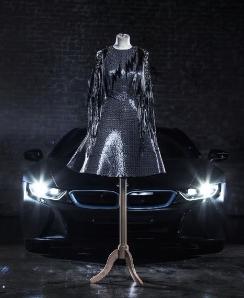The BMW i3 and the BMW i8 are quite a source of inspiration for a lot of people, from wildly various fields. Two fashion designers decided to launch an interesting collection that includes a dress made out of carbon fiber to celebrate their 10th anniversary since they went into the clothing business.
BMW together with Daniela and Annette Felder joined forces to bring out this collection that is claimed to be sustainable. The German twins of London-based design company Felder Felder, came up with this idea, using exclusively up-cycled and sustainable fabrics. The collection’s hero piece is the “Carbon Dress”, inspired by BMW i and created using carbon fiber from BMW’s electric vehicle program.
Carbon material makes up 97% of the fringe-detailed, metallic grey skater dress, which took over 100 hours to make. The unique texture and shine of the material provides a futuristic finish, which remains lightweight and strong, but is more tactile and daring compared to other fashion fabrics. This combined with the cut of the dress makes it the star of the collection.
The fully sustainable material, not yet available to the fashion industry in large quantities, was created at the same plant that produces carbon fiber for BMW, near Moses Lake in the Washington state. This is the second time Felder Felder has collaborated with BMW i to create a more sustainable and green collection.
‘The carbon fabrics are amazing and unlike anything we’ve used before – we are honored to be given access to them before anyone else. The woven fiber allows us to do more with the designs and push the boundaries of sustainable fashion. It adds amazing structure and the frayed carbon looks so great as tassels. We can’t wait to show everyone the collection,” said Daniela and Annette Felder.












